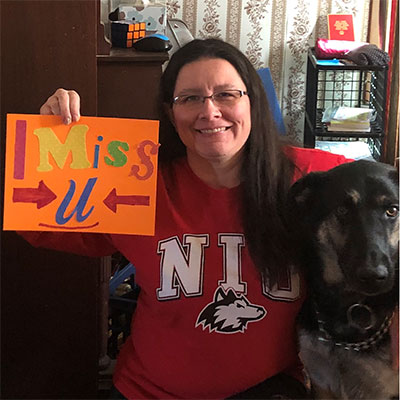
Jeremy Rehmus works full time as the manager of a restaurant in Oswego, where he lives with his wife and their 4-year-old son and 2-year-old daughter.
With many restaurants remaining “essential” and open during the stay-at-home order, his is one experiencing great business as he logs 50-hours weeks.
But the senior Middle Level and Teaching major is also continuing – as much as possible – to student-teach language arts this spring at Eastview Middle School in Elgin U-46.
Like all schools in Illinois, Eastview is closed to stem the spread of coronavirus (COVID-19) while its students learn remotely. Rehmus is contributing to that effort with the creation of an interactive, animated PowToons video lesson for his seventh-graders.
“My cooperating teacher and I had worked on one previously for a different lesson. She had just learned how to do it, and showed me what it was all about,” Rehmus says. “Once the online learning thing happened, I asked her how I could still help her out. I was supposed to do a lesson on counterarguments in class, and I thought, ‘Oh, I can adapt that.’ ”
His cooperating teacher reviewed his work and suggested some changes in the question-prompts that are now part of the assignment the seventh-graders will receive this week through their computers.

“It’s relatively short and pretty easy to follow, and it hits on what they need to do,” he says. “They’re having to think about their response that link into what the video is telling them.”
Rehmus, 45, will graduate next May after returning to college for his B.S.Ed. after decades of employment in food service.
“Teaching is something I’ve always wanted to do. Many, many years ago, I did AmeriCorps and did service-learning in the Indianapolis Public Schools,” he says, “and I finally decided it was time to go back to what I really wanted to do in life.”
- Keep learning, keep teaching: Students, alums detail their COVID-19 adjustment – Part 1
- Educators in Action: Share your stories!

Donna Cairy is a special education teacher at Monroe High School in Monroe, Wis., where she is doing her best to monitor the needs of her students with many types of disabilities.
Some need minimal supports, she says, while others non-verbal or still learning to read. Being at school provides them with structure, sets limits and holds students to those limits.
“Our speech therapist has done teletherapy the entire year, and I’ve seen some of the cool things she does. All the kids have Chromebooks, and I thought, ‘Well, this is easy.’ We can still see their faces, and we can stay connected,” says Cairy, who earned her B.S.Ed. in Special Education from the NIU College of Education in 2000.
“I’m texting with them, and we’re video-chatting on Google Hangout, just for a half-hour or so. I’m just checking in: ‘How are you doing? How are classes going? Can I help you with anything specifically?’ ”
Many “just want to talk,” she adds.
“They just want to know that someone’s out there and hearing them,” she says. “For a lot of them, home is not the best place or the safest place, and now they’re stuck there. At school, they know what to expect, and when kids don’t have that, a lot of them crave it.”

Cairy, who also team-teaches chemistry and heads up her district’s life-after-graduation program, came up with an innovative way to help one student log onto Google Classroom for the first time.
“I did it via text,” she says. “I took pictures of each step and sent them to him because he didn’t know how to do it.”
She worries about food insecurity in her district, and is happy to assist in the effort to bring meals directly to front porches.
“Our district has a food delivery program – seven routes – and we’re feeding 350, 400 kids every day,” she says. “There was no income requirement; just a form to fill out that was posted on Facebook.”
Jennifer Schroeder, who teaches second-grade at North Grove Elementary School in Sycamore, sends videos each morning to her students via apps that all children and parents can access.
These include Seesaw and eLearning Choice Boards, says Schroeder, who earned a B.S.Ed. in Elementary Education in 1994.
“The Choice Boards have two choices per subject per day, one being technology-based and the other being paper-pencil-based. Students complete their work at their own pace and can send pictures and videos of their completed work through the Seesaw app,” she says.

Websites such as XtraMath, Zearn, Happy Numbers, Tumblebooks, BookCreator, Prodigy and Storyline Online are waiving fees during COVID-19, she adds, allowing students to use them free-of-charge directly on those pages or through Google drives.
“The feedback from parents has been so positive. We recently sang ‘Happy Birthday’ and made signs to hold up on Google Meet for a classmate’s eighth birthday,” she says. “They love that sense of normalcy, and personally, so do I! It’s so refreshing to see each other’s faces, hear each other’s voices and do something that was part of our daily routine.”

